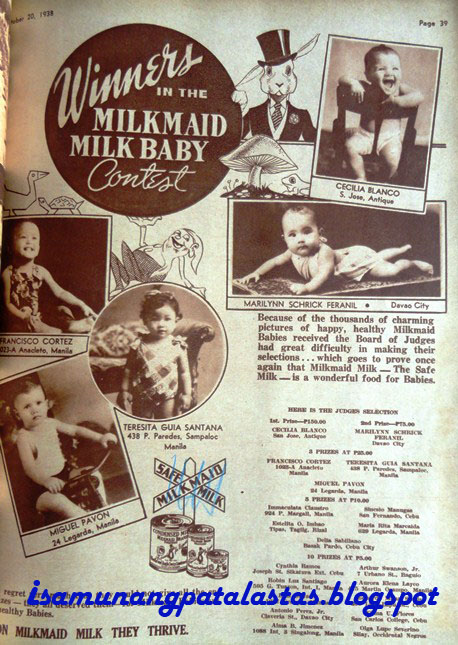 |
| MILKMAID EVAPORATED MILK, AD, 1929 |
The milk known in the Philippines for many years as “Marca Señorita” because of its female
brand character, was a product of a dairy company founded by two American
brothers, George Ham Page and Charles Page, from Dixon, Illinois.
Their story
began in 1865, when Charles, who was the U.S. Vice Consul of Trade was posted
in Zurich, where he marveled at the sight of endless green meadows populated by
grazing cows. He saw the potential of producing a new kind of processed milk
that was clean and pure, and did not spoil easily due to the addition of sugar.
 |
| MILKMAID SWEETTENED CONDENSED STRIP AD, 1929 |
Developed by Gail Borden in the 1850s, the canned
“condensed milk” was supplied to American Civil War soldiers in the
battlefield. Charles’s brother, George, had learned the process of making
condensed milk himself, from the Gail
Borden plant in the U.S. The two brother, thus, joined their heads together, to
form the Anglo-Swiss Condensed Milk Company a year later, in Cham, Switzerland
—the first condensed milk company in Europe—and the future international dairy
giant was born.
The condensed milk product took the world by storm. By 1868, the brothers’ Anglo-Swiss company was
selling over 374,000 cartons of
condensed milk, driven largely by demands from Great Britain and its colonies.
With the death of Charles in 1873, George took over the helm and by 1891, the
company had 12 factories in Europe and the US which exported their famed
condensed milk worldwide, under the “MILKMAID” brand.
Meanwhile, in another part of Switzerland, German immigrant Henry Nestlé had started
making waves with a new milk product produced by his Vevey plant. Introduced in
1867, Farine Lacteé, an infant feeding formula, became a huge marketing
success. It was just a matter of time that Nestlé expanded its product line and
emerged as a rival of the Anglos-Swiss Dairy Company. Despite the competition,
both companies thrived due to their shared passion for producing milk products
of the highest quality and standards.
While talks of a merger were initially opposed by George
Page, his death in 1899 paved the way for the two companies to finally join
forces, and in 1905, a deal was sealed with the creation of the Nestlé and
Anglo-Swiss Condensed Milk Company.
As early as 1895, Nestle products like Bear Brand, were
being marketed in the Philippines. It was only in 1911 that the sales office of
Nestle and Anglo-Swiss Dairy Company was put up here, along Calle Renta in
Binondo.
By the 1920s, there were already 3 milk processing plants
in the country led by San Miguel’s Magnolia. To keep up with the growing demand
for milk, these plants began importing European milk and reconstituted them
locally. It was in this way that Bear Brand and MILKMAID became widely available in the Philippines, becoming
household names.
MILKMAID
was highly promoted in the Philippines,
and both its evaporated and condensed milk versions were advertised in print
ads published in local magazines.
Curiously, because of the bucket-carrying milkmaid trademark illustration that identified the product, Filipinos began referring to MILKMAID as “Marca Señorita” (mark of a Miss), as Spanish was still a major language in the Philippines then. In other countries where it was sold , MILKMAID was translated in the native languages—La Lechera (Spanish), La Laitière (French), Die Milchmädchen (German).
Curiously, because of the bucket-carrying milkmaid trademark illustration that identified the product, Filipinos began referring to MILKMAID as “Marca Señorita” (mark of a Miss), as Spanish was still a major language in the Philippines then. In other countries where it was sold , MILKMAID was translated in the native languages—La Lechera (Spanish), La Laitière (French), Die Milchmädchen (German).
MILKMAID
gained more popularity with its ingenious promotions, including launching the search
for the happy, healthy babies of the Philippines back in the late 1920s, that
was regularly held till the 1930s. It encouraged parents to send photos of
their bouncing, beautiful babies, and selected winners had the photos published
in the leading magazines of the day.
Another promotion engaged MILKMAID users to save and collect labels to be used to get
porcelain tableware marked with the brand logo. The set-building promotion included
plates, saucers, cups, milk pitchers that were avidly collected by housewives
for their homes.
In 1955, Filipro, Inc. acquired the license to produce
and market MILKMAID locally, and
which later became the local Nestlé company here. MILKMAID
cans had “A Nestlé Product” printed on the label.
With the surge in prices of goods in 1959, the government stepped in to form the National Marketing Corporation (NAMARCO) to procure, buy, and distribute such commodities in short supply, with a special non-recurring dollar allocation from the Central Bank. MILKMAID was one such product endorsed by NAMARCO.
 |
| THE HOUSEHOLD FAVORITE FOR MORE THAN 50 YEARS, 1962 |
Throughout the 50s and 60s decade, MILKMAID advertising continued, and its position in the market was
firmly entrenched,until the rise of new evaporated brands in the country like
Liberty and Darigold. Despite its core
loyal users, MILKMAID started
looking more traditional as modern
canned milk brands with new formulations gained their foothold.
In the 1970s, MILKMAID regained prominence with the “grow Tall, Little Man” campaign, topbilled by then-chils superstar, Nino Muhlach.
 |
| THEIR HEALTH IS PRECIOUS!",MILKMAID AD, 1961 |
In 2007, Nestlé gave
Alaska Milk Corp. the license to manufacture and sell its MILKMAID sweetened condensed milk in the Philippines. Alaska Milk
Corp, was acquired by FrieslandCampina in 2012, but the plant continues to produce
MILKMAID, but no longer carries the Nestlé name. MILKMAID today is promoted as
an ingredient for modern confections, sweet treats, dessserts, and bakery items.
SOURCES:
A Condensed History: Th Page Brothers and Anglo Swiss https://www.nestle.com/aboutus/history/nestle-company-history/page-brothers-anglo-swiss













No comments:
Post a Comment